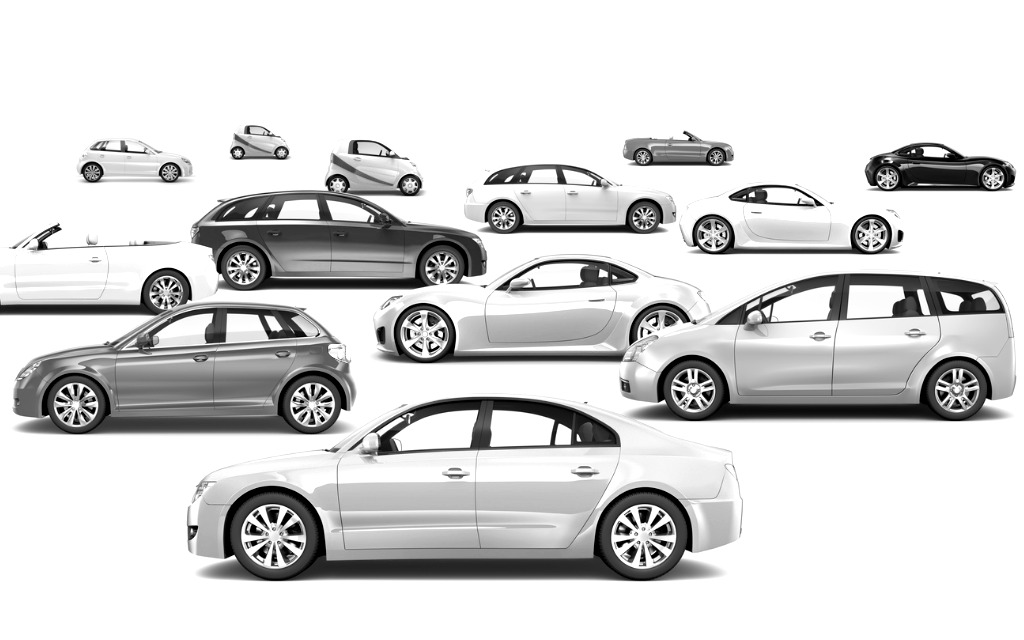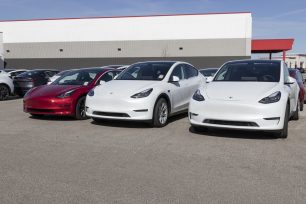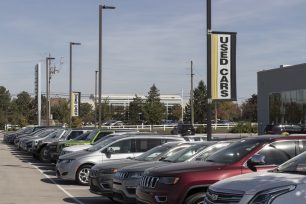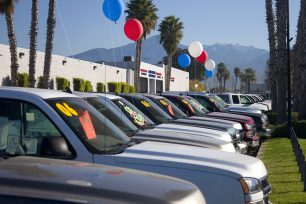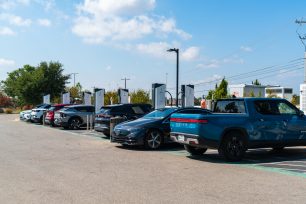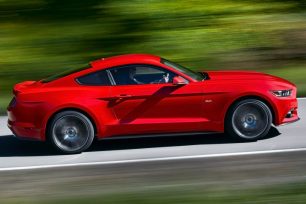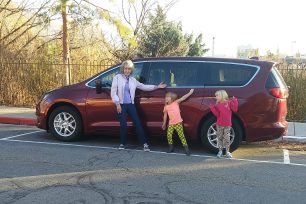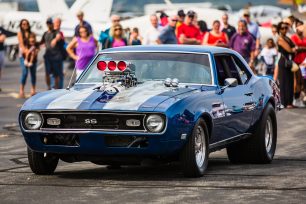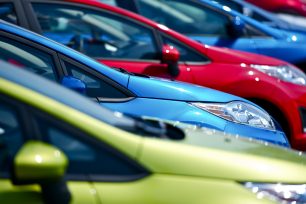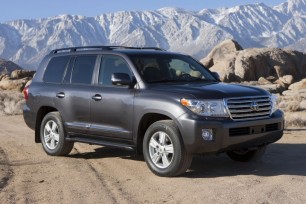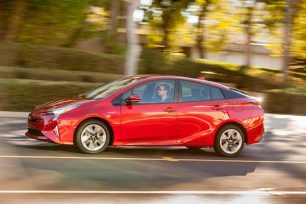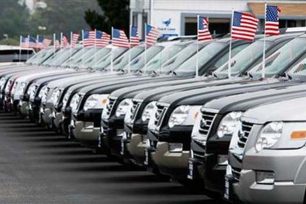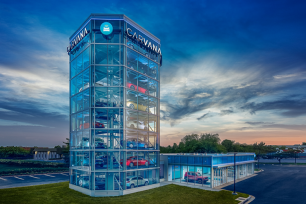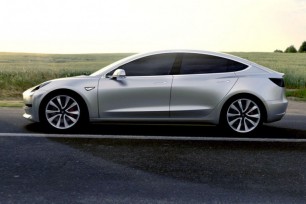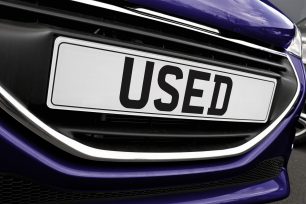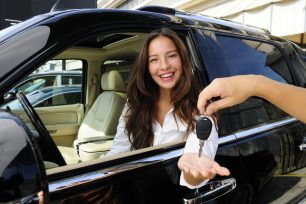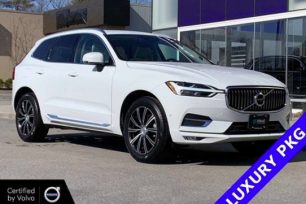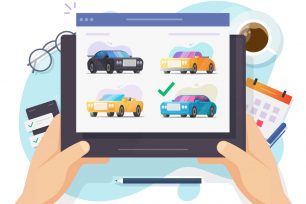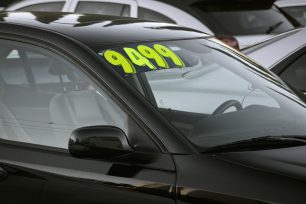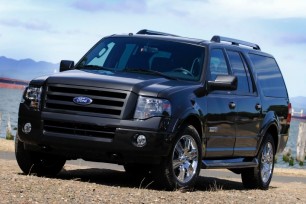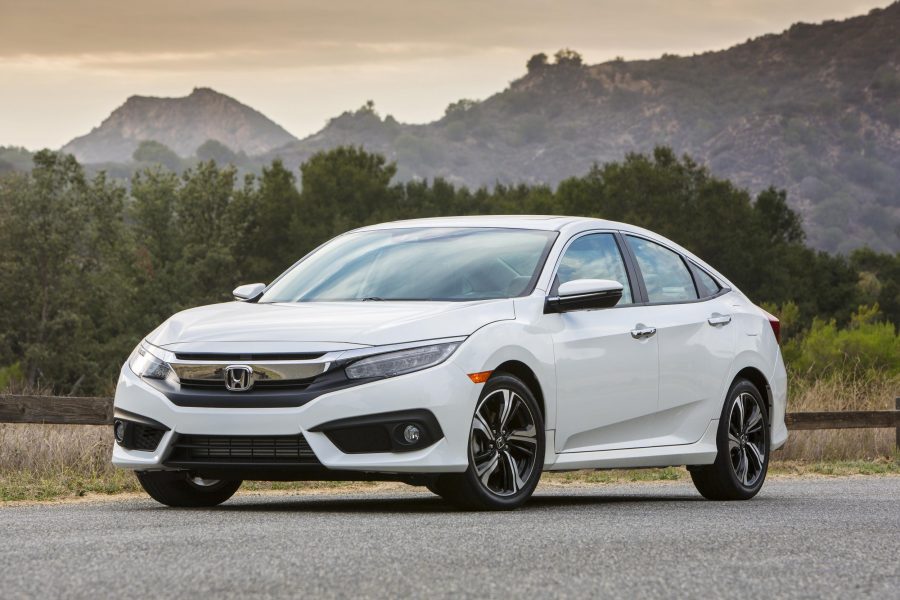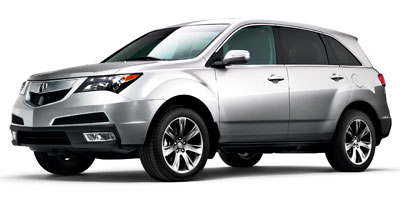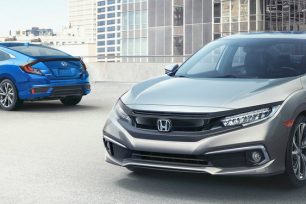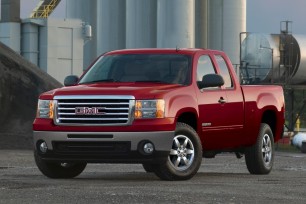Highlights:
- White is the most popular color in 40 states, with black the most popular in the remaining 10 states
- The dominance of grayscale colors continues to rise, moving from 77.2 percent in 2018 to 78.9 percent in 2023.
- Gray is the big winner, up 4 percent in market share since 2018; silver is the big loser, down 3.4 percent
- Gray, white, blue, and orange all gained substantial market share, while silver, red, black, and brown lost ground
- Cars in uncommon colors like beige and yellow held their value better than mainstream colors
iSeeCars’ latest car color study looks at the most popular colors from 2018 and compares them to 2023 to track how car color preferences have shifted over the past 5 years. The study confirms that, as in 2018, white, black, gray, and silver remain the most popular car colors for 2023. These four shades, often referred to as the “grayscale” colors, were found on 77.2 percent of 1- to 5-year-old used cars in 2018, and that number had increased to 78.6 percent last year, and moved up again to 78.9 percent in 2023. Within that group, gray made the biggest move, gaining 4 percent since 2018. Silver is the biggest loser, dropping 3.4 percent.
iSeeCars analyzed over 10 million 1- to 5-year-old used cars sold in 2018 and 2023. While the most popular car colors, in broad strokes, roughly stayed the same, some colors have moved up and down in popularity over this period.
“While white, black, gray, and silver remain the dominant colors, it’s interesting to see how far silver has fallen,” said iSeeCars Executive Analyst Karl Brauer. “Silver is now just 2 percentage points above blue, which has displaced red as the fifth most popular color.”
| Most Popular Car Colors – iSeeCars Study | ||||
| Rank 2023 | Color | Market Share 2023 | Rank 2018 | Market Share 2018 |
| 1 | White | 26.2% | 2 | 23.3% |
| 2 | Black | 21.8% | 1 | 23.6% |
| 3 | Gray | 19.2% | 3 | 15.2% |
| 4 | Silver | 11.7% | 4 | 15.1% |
| 5 | Blue | 9.7% | 6 | 8.5% |
| 6 | Red | 8.2% | 5 | 10.6% |
| 7 | Green | 1.0% | 8 | 0.8% |
| 8 | Brown | 0.8% | 7 | 1.7% |
| 9 | Orange | 0.6% | 9 | 0.3% |
| 10 | Beige | 0.4% | 11 | 0.3% |
| 11 | Purple | 0.2% | 13 | 0.1% |
| 12 | Gold | 0.2% | 10 | 0.3% |
| 13 | Yellow | 0.1% | 12 | 0.2% |
The color of money: Changes since the pandemic
How does a car’s color impact its price? As iSeeCars has explored in previous research, the most unpopular colors can be the most valuable. Consistent with many other studies tracking used car prices around the pandemic, used car prices spiked from 2018 to 2023 with a 50 percent increase overall due to the pandemic shutdowns and related supply chain issues. But breaking the prices out by individual color reveals dramatic differences in price increases for particular colors.| Change in Average Price By Car Color: 2018 vs. 2023 – iSeeCars Study | ||||
| Rank | Color | Average Price 2023 | Average Price 2018 | % Price Change 2018 – 2023 |
| 1 | Beige | $38,001 | $18,690 | 103.3% |
| 2 | Yellow | $49,043 | $26,430 | 85.6% |
| 3 | Green | $39,911 | $22,796 | 75.1% |
| 4 | Red | $33,622 | $21,417 | 57.0% |
| 5 | Blue | $33,320 | $21,449 | 55.3% |
| 6 | Gray | $33,011 | $21,520 | 53.4% |
| Overall Average | $34,130 | $22,685 | 50.4% | |
| 7 | Gold | $30,315 | $20,206 | 50.0% |
| 8 | White | $35,503 | $23,980 | 48.1% |
| 9 | Black | $35,491 | $24,221 | 46.5% |
| 10 | Brown | $33,012 | $22,576 | 46.2% |
| 11 | Silver | $30,786 | $21,070 | 46.1% |
| 12 | Orange | $33,623 | $24,280 | 38.5% |
| 13 | Purple | $32,180 | $24,107 | 33.5% |
In 2023, with used cars in short supply, consumers are buying whatever vehicle they can find that fits their needs and budget. That means even beige cars are now desirable, and as a percentage of what they cost 5 years ago, their prices increased the most.
Rare colors like yellow and green increased more than average. “These price bumps aren’t a reflection of color popularity, but of supply and demand,” said Brauer. “Not many people want a yellow car, but far more people want one than exist.”
“With regard to beige, we’ve seen the same story with economy cars,” said Brauer. “Cars that weren’t as desirable before the pandemic have been swept along with the price increases impacting the entire used car market. That means vehicles with relatively low prices in 2018 have, as a percentage of their previous price, gone up the most. This includes previously unremarkable beige cars, which are now much more valuable simply because they are part of today’s massively elevated used car market.”
Car color popularity by body style
The colors white and black dominate the car market, as reflected in their popularity across every major body style. However, the shift for specific body styles over the past 5 years is interesting. In 2018, these two colors were split among the eight body styles, with each one holding the lead in four categories. In 2023, only coupes remain the most popular in black, with convertibles, sedans, and SUVs switching to white as the most popular color.| Most Popular Colors by Vehicle Type – iSeeCars Study | ||||
| Body Type | Most Popular Color, 2023 | Most Popular Non-Grayscale Color, 2023 | Most Popular Color, 2018 | Most Popular Non-Grayscale Color, 2018 |
| Convertible | White | Red | Black | Red |
| Coupe | Black | Red | Black | Red |
| Hatchback | White | Blue | White | Red |
| Minivan | White | Red | White | Red |
| Pickup | White | Red | White | Red |
| Sedan | White | Blue | Black | Red |
| SUV | White | Blue | Black | Red |
| Wagon | White | Red | White | Blue |
What are the most colorful states?
While the world is increasingly filled with non-colorful cars, this lack of color isn’t consistent across states. In the table below states are ranked by their percentage of used cars which are non-grayscale. By this metric, Alaska is the most colorful state and Hawaii is the most drab. It’s interesting to see the two non-contiguous states at opposite ends of the spectrum.| Most Colorful States and Top Colors – iSeeCars Study | ||||||
| Rank | State | % Market Share of Colorful Cars* | Most Popular Car Color | Most Popular Non-Grayscale Color | ||
| Color | Market Share | Color | Market Share | |||
| 1 | Alaska | 27.3% | White | 22.3% | Blue | 13.4% |
| 2 | West Virginia | 26.9% | White | 23.3% | Red | 11.5% |
| 3 | Vermont | 25.8% | Black | 20.6% | Blue | 12.1% |
| 4 | Wisconsin | 25.4% | Black | 24.6% | Blue | 10.9% |
| 5 | Maine | 25.3% | Black | 21.9% | Blue | 11.1% |
| 6 | Wyoming | 25.0% | White | 27.5% | Red | 10.2% |
| 7 | Michigan | 24.8% | Black | 24.1% | Blue | 11.0% |
| 8 | North Dakota | 24.7% | White | 25.5% | Red | 11.1% |
| 9 | Nebraska | 24.5% | White | 26.1% | Red | 11.3% |
| 10 | South Dakota | 24.4% | White | 25.2% | Red | 10.7% |
| 11 | Pennsylvania | 24.4% | White | 23.4% | Blue | 11.5% |
| 12 | Indiana | 24.3% | Black | 23.2% | Blue | 10.5% |
| 13 | Ohio | 24.2% | Black | 23.2% | Blue | 10.8% |
| 14 | Delaware | 23.7% | White | 24.2% | Blue | 12.1% |
| 15 | Montana | 23.4% | White | 28.5% | Blue | 9.7% |
| 16 | New Mexico | 23.2% | White | 27.2% | Blue | 9.5% |
| 17 | Minnesota | 23.1% | White | 24.2% | Blue | 10.1% |
| 18 | Iowa | 23.1% | White | 26.3% | Red | 10.8% |
| 19 | Kansas | 22.7% | White | 27.0% | Blue | 9.9% |
| 20 | Virginia | 22.6% | White | 24.0% | Blue | 11.2% |
| 21 | New York | 22.3% | Black | 24.3% | Blue | 11.2% |
| 22 | Illinois | 22.1% | Black | 24.6% | Blue | 10.2% |
| 23 | Missouri | 22.1% | White | 25.5% | Blue | 9.4% |
| 24 | Kentucky | 22.0% | White | 25.9% | Blue | 9.3% |
| 25 | Colorado | 21.9% | White | 26.3% | Blue | 10.3% |
| 26 | Maryland | 21.6% | White | 23.5% | Blue | 11.3% |
| 27 | Idaho | 21.6% | White | 29.2% | Blue | 9.2% |
| 28 | Washington | 21.4% | White | 26.9% | Blue | 10.2% |
| 29 | Connecticut | 21.2% | Black | 23.8% | Blue | 11.6% |
| 30 | Arkansas | 21.2% | White | 28.9% | Red | 10.1% |
| Overall National Average | 21.1% | White | 26.2% | Blue | 9.7% | |
| 31 | Florida | 21.0% | White | 27.4% | Blue | 9.7% |
| 32 | Oregon | 20.9% | White | 26.5% | Blue | 9.8% |
| 33 | North Carolina | 20.6% | White | 26.7% | Blue | 9.6% |
| 34 | New Hampshire | 20.5% | White | 31.6% | Blue | 10.4% |
| 35 | Tennessee | 20.5% | White | 25.9% | Blue | 8.9% |
| 36 | Massachusetts | 20.5% | Black | 24.3% | Blue | 10.9% |
| 37 | Arizona | 20.4% | White | 30.2% | Blue | 8.9% |
| 38 | Rhode Island | 20.4% | White | 24.5% | Blue | 10.5% |
| 39 | South Carolina | 20.3% | White | 26.8% | Blue | 9.0% |
| 40 | Texas | 20.3% | White | 27.4% | Blue | 8.7% |
| 41 | Nevada | 20.1% | White | 27.9% | Blue | 9.2% |
| 42 | Georgia | 19.4% | White | 26.8% | Blue | 8.8% |
| 43 | Oklahoma | 19.3% | White | 26.6% | Red | 8.6% |
| 44 | Alabama | 19.0% | White | 28.3% | Red | 8.0% |
| 45 | New Jersey | 18.9% | White | 25.6% | Blue | 10.1% |
| 46 | Utah | 18.7% | White | 30.4% | Blue | 8.3% |
| 47 | Mississippi | 17.6% | White | 29.9% | Red | 7.4% |
| 48 | Louisiana | 17.4% | White | 29.0% | Blue | 7.5% |
| 49 | California | 16.7% | White | 30.5% | Blue | 8.3% |
| 50 | Hawaii | 16.3% | White | 28.5% | Blue | 8.5% |
“Maybe people in Alaska are looking for any excuse to see color during those long winter months, while people in Hawaii are the happiest to tone things down a bit in the tropics,” said Brauer. “I suspect at least some of this is driven by rental cars, with Hawaii likely having one of the highest percentage of rental vehicle fleets, and rental agencies playing it ‘safe’ when ordering car colors.”
What are the most colorful cities?
iSeeCars also ranked the top 50 metro areas by their percentage share of colorful used cars. The Harrisburg-Lancaster-York metro area in Pennsylvania is the most diverse for car colors, while Los Angeles is the most dominated by grayscale colors.| Most Colorful Metro Areas and Top Colors – iSeeCars Study | ||||||
| Rank | Metro Area | % Market Share of Colorful Cars* | Most Popular Car Color | Most Popular Non-Grayscale Color | ||
| Color | Market Share | Color | Market Share | |||
| 1 | Harrisburg-Lancaster-York, PA | 26.2% | White | 23.0% | Blue | 12.2% |
| 2 | Pittsburgh, PA | 25.0% | White | 23.4% | Blue | 10.6% |
| 3 | Indianapolis, IN | 24.6% | Black | 24.2% | Blue | 10.6% |
| 4 | Detroit, MI | 24.5% | Black | 26.1% | Blue | 11.0% |
| 5 | Cleveland-Akron (Canton), OH | 24.3% | Black | 23.8% | Blue | 10.8% |
| 6 | Cincinnati, OH | 24.2% | Black | 24.5% | Blue | 11.0% |
| 7 | Milwaukee, WI | 24.1% | Black | 25.8% | Blue | 10.7% |
| 8 | Louisville, KY | 24.1% | White | 24.0% | Red | 10.5% |
| 9 | Grand Rapids-Kalamazoo, MI | 23.8% | Black | 24.3% | Blue | 10.5% |
| 10 | Columbus, OH | 23.4% | Black | 24.5% | Blue | 10.0% |
| 11 | Minneapolis-St. Paul, MN | 23.2% | Black | 25.0% | Blue | 9.8% |
| 12 | Norfolk-Portsmouth-Newport News,VA | 23.2% | White | 22.9% | Blue | 11.0% |
| 13 | Washington, DC (Hagerstown, MD) | 22.8% | Black | 24.0% | Blue | 11.3% |
| 14 | Albuquerque-Santa Fe, NM | 22.8% | White | 26.6% | Blue | 9.6% |
| 15 | Tampa-St Petersburg (Sarasota), FL | 22.6% | White | 26.5% | Blue | 9.8% |
| 16 | St. Louis, MO | 22.6% | White | 24.5% | Red | 9.8% |
| 17 | Baltimore, MD | 22.5% | Black | 23.7% | Blue | 11.4% |
| 18 | Orlando-Daytona Beach, FL | 22.3% | White | 25.8% | Blue | 9.7% |
| 19 | Denver, CO | 22.2% | White | 25.7% | Blue | 10.3% |
| 20 | Hartford & New Haven, CT | 21.9% | White | 24.2% | Blue | 11.2% |
| 21 | Greenville-Spartanburg, SC | 21.9% | White | 26.3% | Blue | 9.2% |
| 22 | Philadelphia, PA | 21.8% | Black | 24.6% | Blue | 10.8% |
| 23 | San Antonio, TX | 21.7% | White | 25.8% | Blue | 9.2% |
| 24 | Seattle-Tacoma, WA | 21.6% | White | 26.4% | Blue | 10.5% |
| 25 | Portland, OR | 21.5% | White | 25.4% | Blue | 9.9% |
| 26 | Kansas City, MO | 21.5% | White | 25.9% | Red | 9.5% |
| 27 | Jacksonville, FL | 21.1% | White | 26.1% | Blue | 9.4% |
| Overall National Average | 21.1% | White | 26.2% | Blue | 9.7% | |
| 28 | Greensboro-Winston Salem, NC | 21.1% | White | 27.1% | Blue | 9.0% |
| 29 | Nashville, TN | 20.9% | White | 25.3% | Blue | 8.9% |
| 30 | West Palm Beach-Ft. Pierce, FL | 20.9% | White | 28.3% | Blue | 9.6% |
| 31 | Chicago, IL | 20.8% | Black | 25.9% | Blue | 9.8% |
| 32 | Boston, MA-Manchester, NH | 20.7% | White | 25.1% | Blue | 10.6% |
| 33 | Raleigh-Durham (Fayetteville), NC | 20.5% | White | 26.2% | Blue | 9.4% |
| 34 | Charlotte, NC | 20.3% | White | 26.3% | Blue | 9.3% |
| 35 | Austin, TX | 20.3% | White | 26.6% | Blue | 8.8% |
| 36 | Oklahoma City, OK | 20.3% | White | 27.5% | Red | 9.5% |
| 37 | Phoenix, AZ | 20.1% | White | 29.7% | Blue | 8.8% |
| 38 | Houston, TX | 19.7% | White | 26.0% | Blue | 8.3% |
| 39 | Las Vegas, NV | 19.7% | White | 28.4% | Blue | 8.5% |
| 40 | Atlanta, GA | 19.5% | White | 26.4% | Blue | 8.6% |
| 41 | Salt Lake City, UT | 19.4% | White | 28.8% | Blue | 8.4% |
| 42 | New York, NY | 19.2% | Black | 25.9% | Blue | 10.1% |
| 43 | Birmingham, AL | 19.1% | White | 27.5% | Red | 8.1% |
| 44 | Miami-Ft. Lauderdale, FL | 18.6% | White | 28.1% | Blue | 8.8% |
| 45 | San Francisco-Oakland-San Jose, CA | 18.4% | White | 29.0% | Blue | 9.4% |
| 46 | Dallas-Ft. Worth, TX | 18.1% | White | 27.5% | Red | 8.2% |
| 47 | Sacramento-Stockton-Modesto, CA | 17.6% | White | 31.3% | Blue | 8.2% |
| 48 | Fresno-Visalia, CA | 17.6% | White | 31.0% | Red | 7.8% |
| 49 | San Diego, CA | 16.9% | White | 30.2% | Blue | 8.2% |
| 50 | Los Angeles, CA | 16.1% | White | 30.0% | Blue | 7.9% |
“There are an awful lot of California cities at the bottom of this list,” said Brauer. “And as a resident of Southern California, I believe it! The preponderance of white, black, gray, and silver cars makes the roadways look like a 1950s TV show. It also means the – very rare – blue, red, green, or orange cars truly stand out when slogging along in stop-and-go traffic.”
Will the trend toward more grayscale cars ever stop? And will red retake the lead from blue as the most popular non-grayscale color? iSeeCars will publish its annual Most Popular Car Color Study again next year to find out.
Methodology
iSeeCars analyzed over 10 million 1- to 5-year-old used cars sold between January and August of 2018 and 2023. The color of each car, as well as the location of sale, was tallied to determine the most popular car color nationally, in each state, and in each metro area.
About iSeeCars.com

